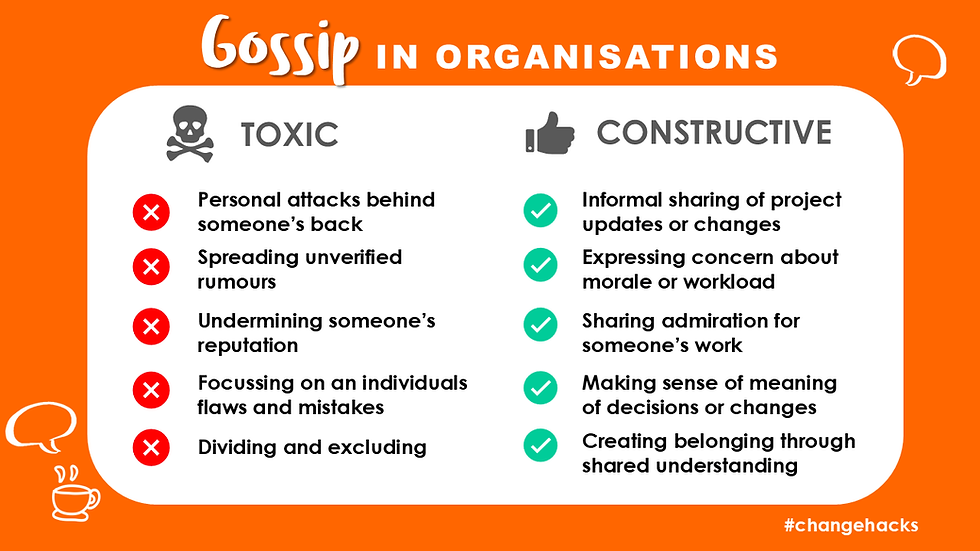The one little truth about gossip
- Lena Ross
- Oct 6
- 3 min read

Let’s talk about gossip
Not the stuff we see on the news or instagram about royals and celebrities. I’m talking about the gossip that shows up in our workplaces.
Gossip often gets a bad rap. We associate it with whispers, drama, and damaging rumours. Of course, gossip can be toxic, especially when it's personal, untrue, or used to undermine others.
But it is always a bad thing?
The one little truth about gossip that we need to know is that was essential to our survival.
We gossiped to survive
Let’s look at our history as humans. We’ve all seen our primate cousins groom each other, picking nits and ticks from each other’s coats. Oxford evolutionary anthropologist and psychologist, Robin Dunbar, who has carried out extensive research on primates has concluded that gossip is the human version of this social grooming carried out by primates.
So gossip is also deeply human. It's also how we’ve shared social cues, built oral history, made sense of our environment, and strengthened our social bonds since we lived in tribes. In modern workplaces, gossip is often a way people try to understand what’s going on beneath the surface.
Gossip in organisations may mean you hear comments like these:
Have you heard anything about that restructure?
Apparently that team is working on a new pilot.
Word is, people are feeling burnt out.
This kind of informal chit-chat offers important insights, not just about what’s happening, but how people are feeling. It’s a powerful signal.
So instead of just trying to eliminate gossip, what if we listened with curiosity and asked ourselves:
What’s behind the buzz?
What are people worried or excited about?
What might be the communication gaps we need to fill?
Blessing or curse?
In the workplace, here’s how we can turn gossip into a blessing rather than a curse:
Stay abreast of the rumours - you can tap into some of the grapevine on enterprise social networks, such as Yammer. Use this channel to ask what is happening at the water cooler and in the corridors. This opens a two-way communication channel to host the gossip and address the rumours.
Provide face-to-face forums for myth-busting, discussion and FAQs. One way is to add ‘myth busting’ as a regular team meeting agenda item. Invite your team to openly talk about the rumours.
Adopt the agile practice of a Lean Coffee meeting. In times of change, this practice provides an ideal outlet, giving permission for people to openly bring up what’s on their minds in a safe forum that’s not driven by a formal meeting agenda.
Following formal face-to-face communication forums, allow time for smaller groups to gather to engage in natural ‘gossip’. Have your team leaders and change champions circulate to tap into this grapevine.
If you cannot communicate detail, advise them when details will be confirmed to provide anchor points.
Set up a rumour or gossip board. Ask your employees to post concerns and rumours on a post-it-note on a board. Offer this outlet as an anonymous one so people feel comfortable sharing what they are hearing.
With this approach, we leverage gossip as a nudge to promote more effective communication. It’s an opportunity to clarify and connect more deeply.
Gossip isn’t going away - it’s wired into us. But when we pay attention to its signals (rather than silence them), we can shift something that is potentially toxic water-cooler chatter to constructive conversations. Check out this diagram for a quick summary of toxic v constructive gossip in organisations.

The facts – key take aways
It’s human
It was essential to our survival, so it’s hard wired
It flourishes in times of uncertainty
It’s not going away.
It is a signal for us to harness the energy and turn it into constructive conversations
We can’t fight with hardwired behaviour. In times of uncertainty, gossip increases and often leads to rumours, and these rumours will continue despite attempts to over-communicate in the hope of eradicating them. The role of leaders, communications managers and change professionals is to leverage this activity that forms part of the human DNA.






























Comments